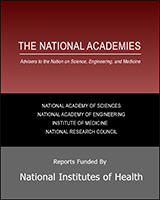NCBI Bookshelf. A service of the National Library of Medicine, National Institutes of Health.
National Research Council (US) Panel to Review Risk and Prevalence of Elder Abuse and Neglect; Bonnie RJ, Wallace RB, editors. Elder Mistreatment: Abuse, Neglect, and Exploitation in an Aging America. Washington (DC): National Academies Press (US); 2003.

Elder Mistreatment: Abuse, Neglect, and Exploitation in an Aging America.
Show detailsReports of this kind typically begin by calling attention to the magnitude and social cost of the problem being explored. The fact that equivalent statements cannot be made with any confidence about elder mistreatment is a telling indication of the need for the report, as well as for an intensified program of research. No survey of the U.S. population has ever been undertaken to provide a national estimate for the occurrence of any form of elder mistreatment; the magnitude of the problem—among community-dwelling elders, as well as those residing in long-term care facilities—is basically unknown. The best estimates, based on figures extrapolated from local studies, suggest that the national prevalence of elder mistreatment (including physical abuse, psychological abuse, and neglect) is between 1 and 2 million.
The occurrence and severity of elder mistreatment are likely to increase markedly over the coming decades, as the population ages, caregiving responsibilities and relationships change, and increasing numbers of older persons require long-term care.
Although the magnitude of elder mistreatment is unknown, its social and moral importance is self-evident. However, there is no solid understanding of the nature, causes, and consequences of elder mistreatment, the effectiveness and cost of current interventions, or measures that could successfully be taken to prevent it or to ameliorate its effects. The purpose of this report is to help the nation remedy this deficiency.
In Understanding Child Abuse and Neglect (1993) and Violence in Families (1998), the National Research Council was able to map out a comprehensive blueprint for research in the adjacent domains of child mistreatment and intimate partner violence. However, so little is now known about elder mistreatment that it would be premature to draw up a detailed research agenda for this nascent field. Instead, this report is best seen as laying the foundation for a much-needed scientific effort. The panel emphasizes the need to develop a better understanding of elder mistreatment in its different forms, to develop better measures for it, and to undertake a variety of population-based studies to ascertain prevalence and risk factors. Several priorities for research are identified in relation to the determinants of elder mistreatment, clinical screening and case identification, and preventive interventions.
We are not the first to lament the poor state of knowledge about elder mistreatment. In 1986, a consensus conference of leading researchers (including two of our panel members) was convened at the University of New Hampshire to point the way toward advancing knowledge. The conclusions and recommendations reached at that conference are strikingly similar to those appearing in this report.
One of the participants at the New Hampshire conference was Rosalie Wolf, by all accounts one of the founding leaders of the elder mistreatment field. The panel expressed its deep gratitude to Dr. Wolf for presenting her views at our initial meeting, despite her poor health, and was devastated when she passed away within weeks of her appearance at our meeting. We are publishing the remarks that she delivered at that meeting as an appendix to this report. Indeed, our report is in many ways a tribute to Dr. Wolf's heroic efforts over three decades to nurture the field of elder mistreatment research.
Abuse and neglect of older individuals in society breaches a widely embraced moral commitment to protect vulnerable people from harm and to ensure their well-being and security. To carry out this commitment, one cannot rely on good intentions alone. A substantial investment in scientific research along the lines outlined in this report is imperative to enable society to enhance its understanding of elder mistreatment and to mount an effective response to it in the 21st century.
Richard J. Bonnie, Chair
Panel to Review Risk and Prevalence of Elder Abuse and Neglect
- Preface - Elder MistreatmentPreface - Elder Mistreatment
Your browsing activity is empty.
Activity recording is turned off.
See more...